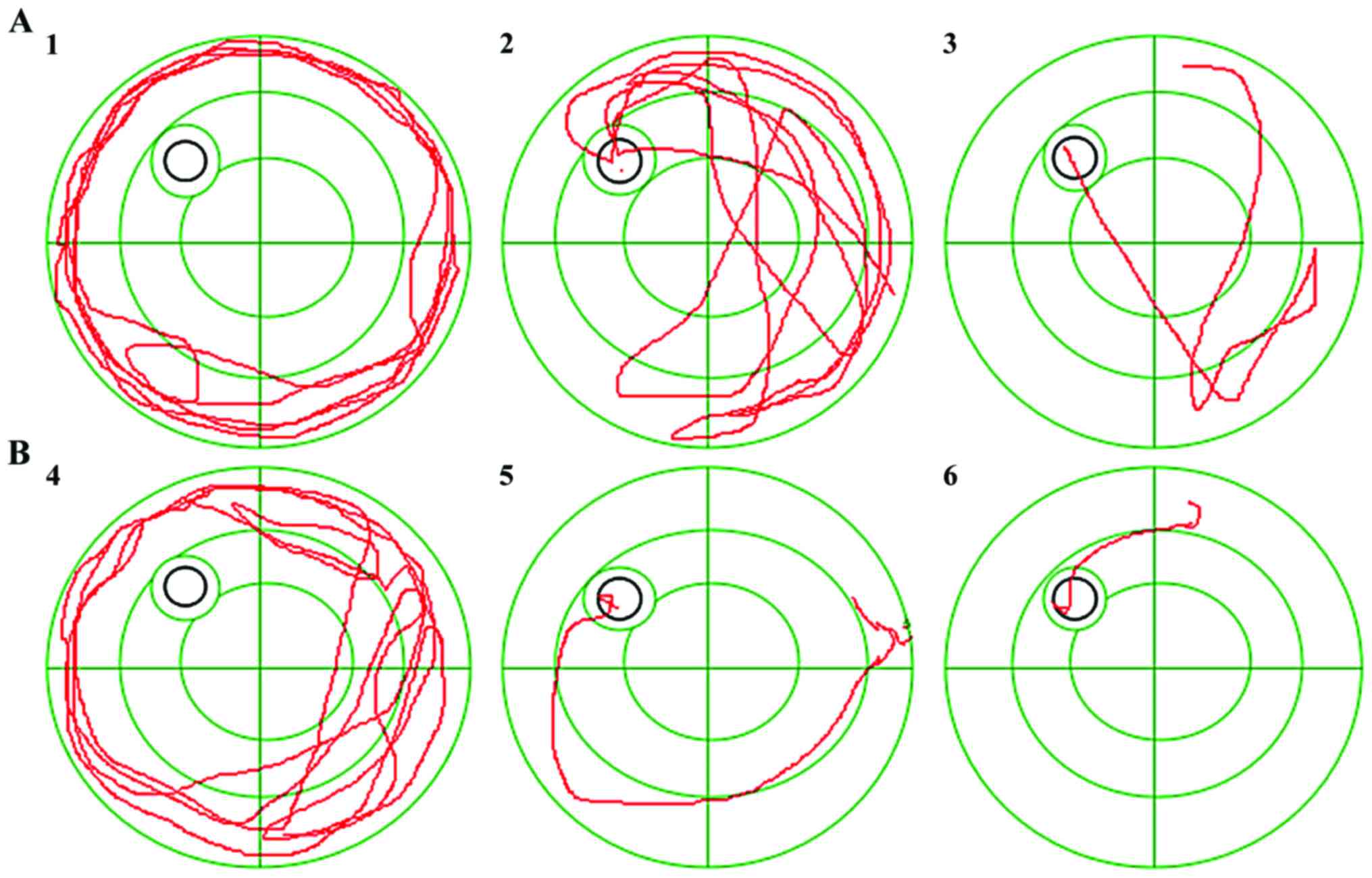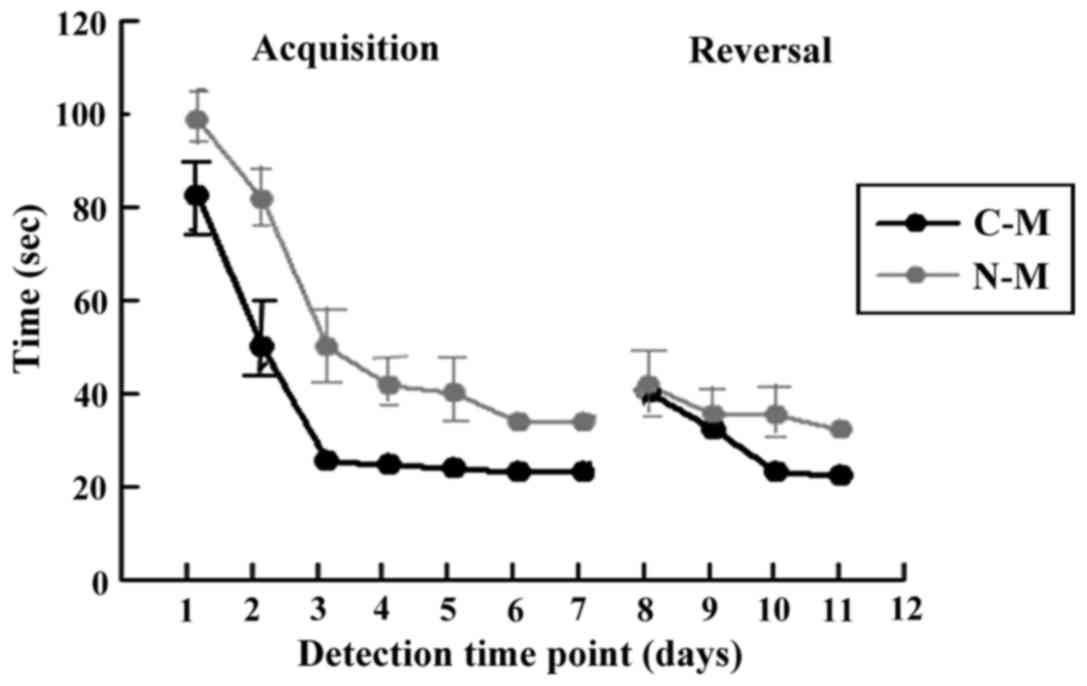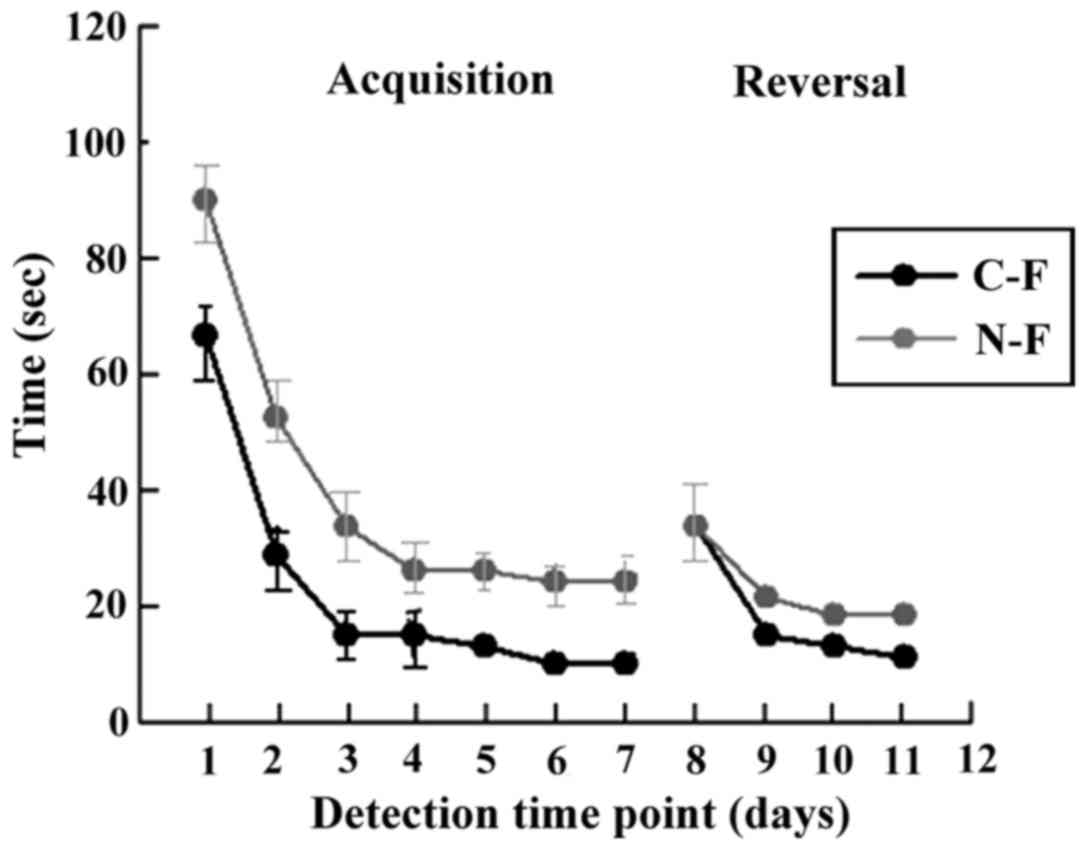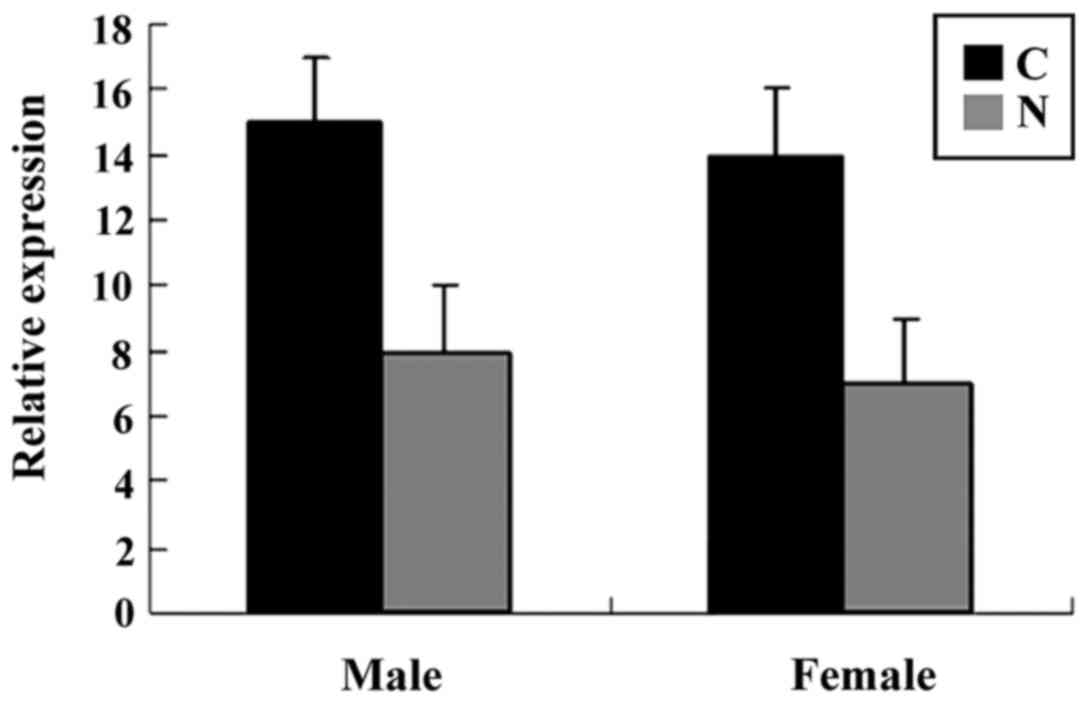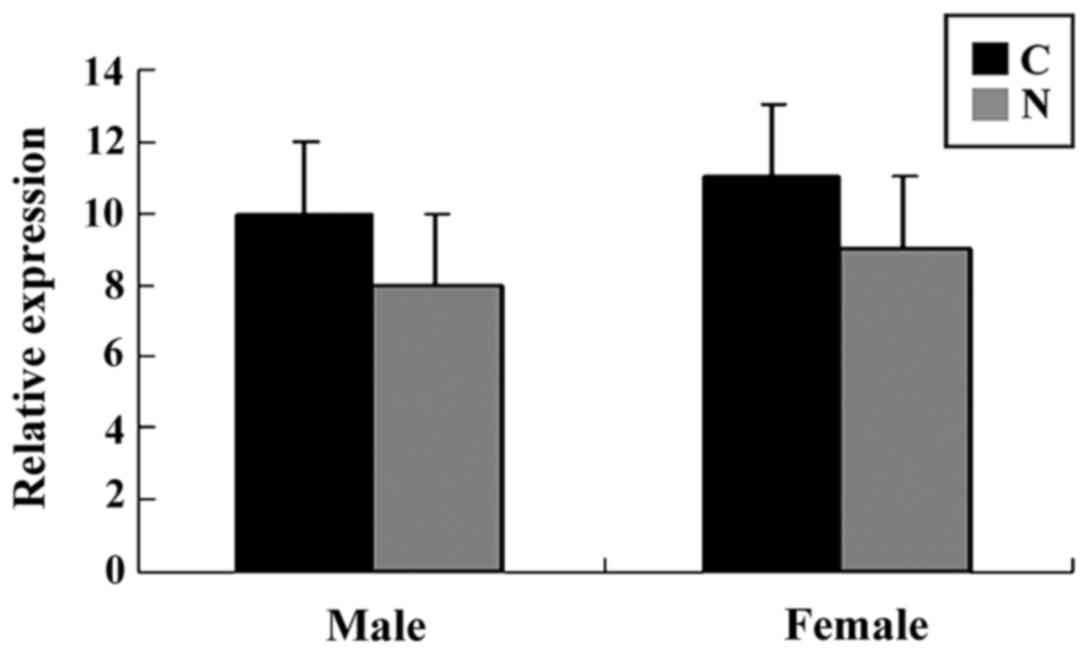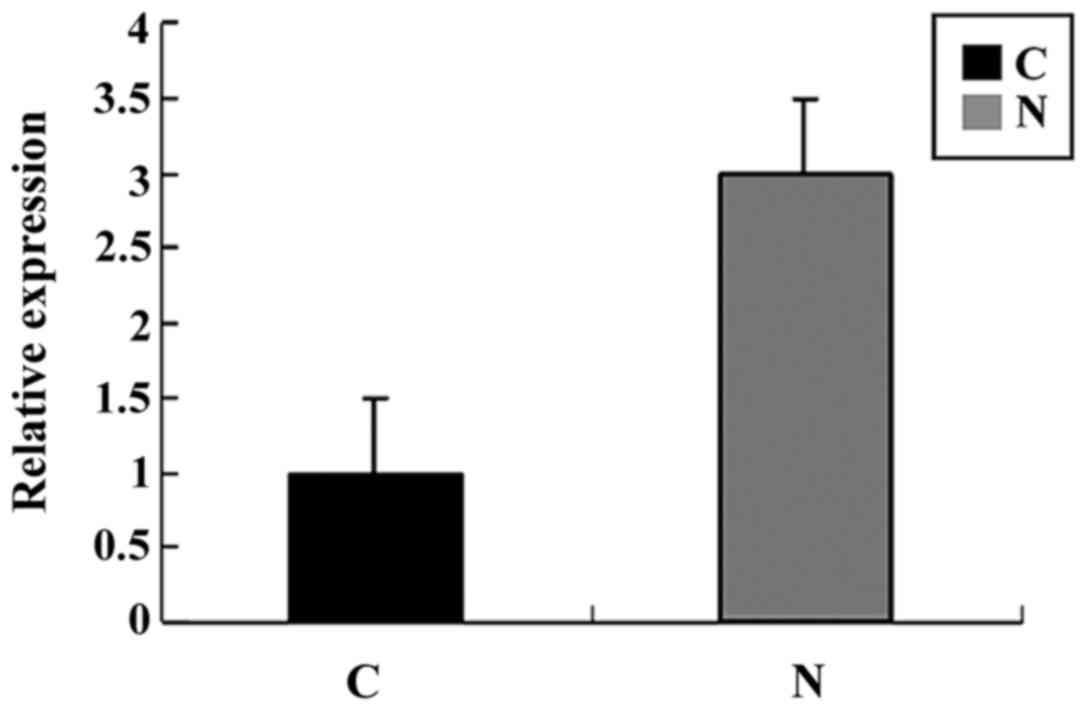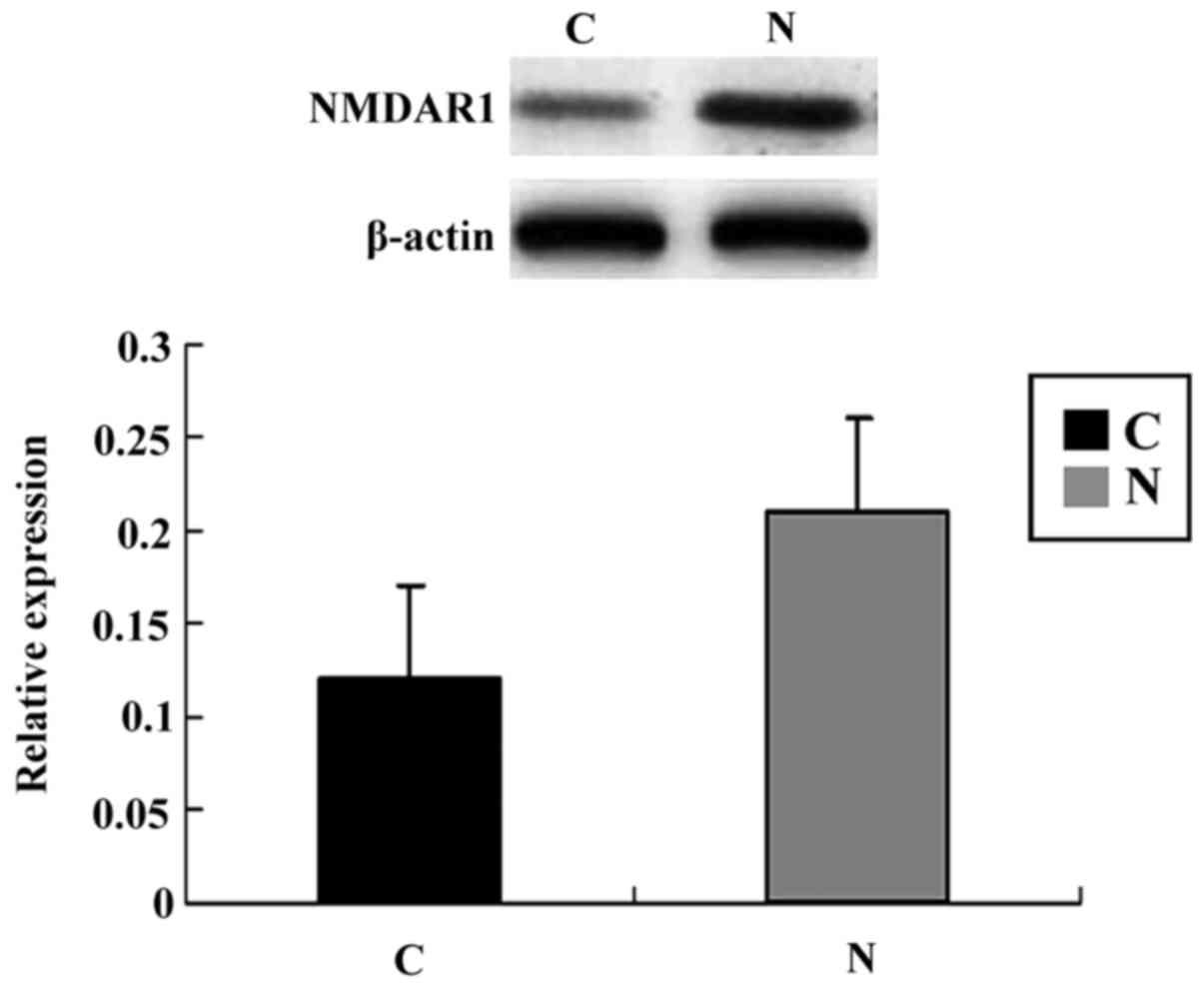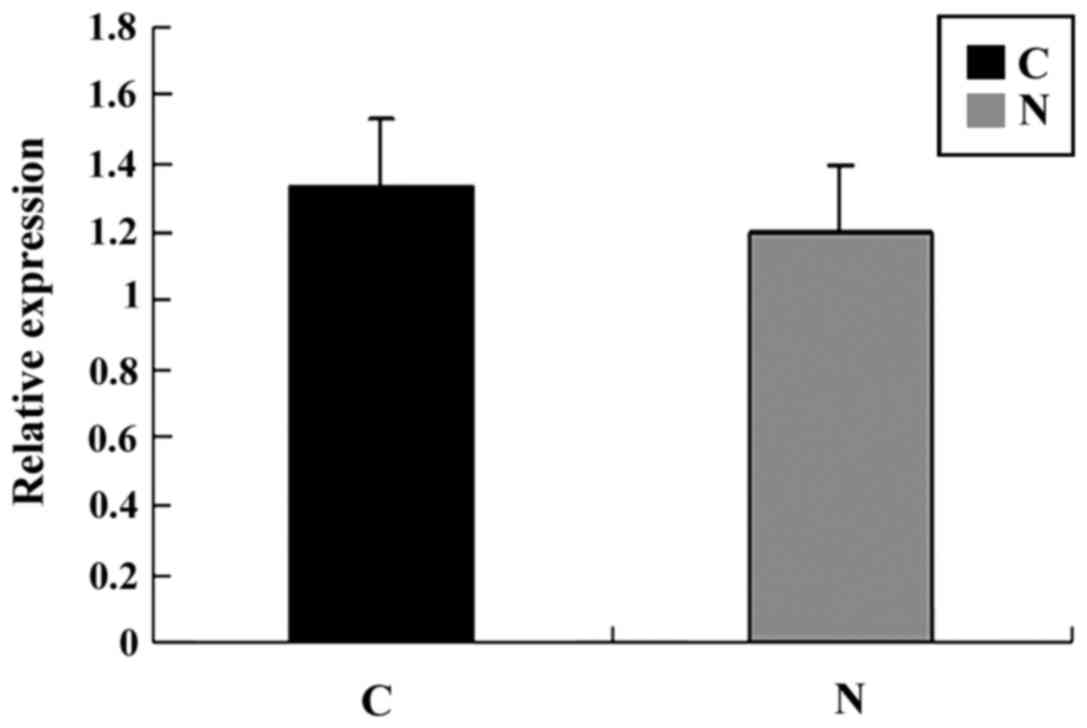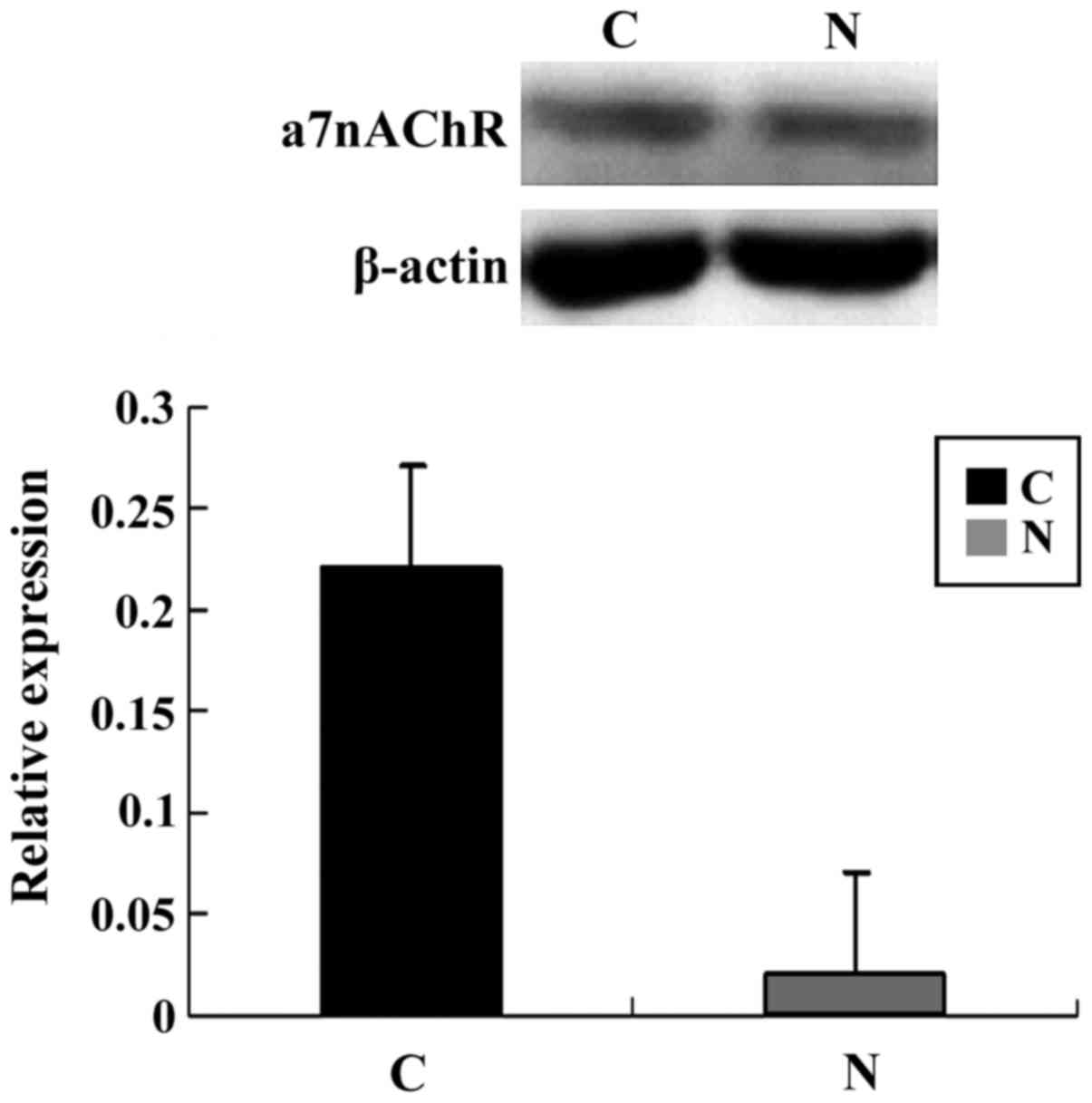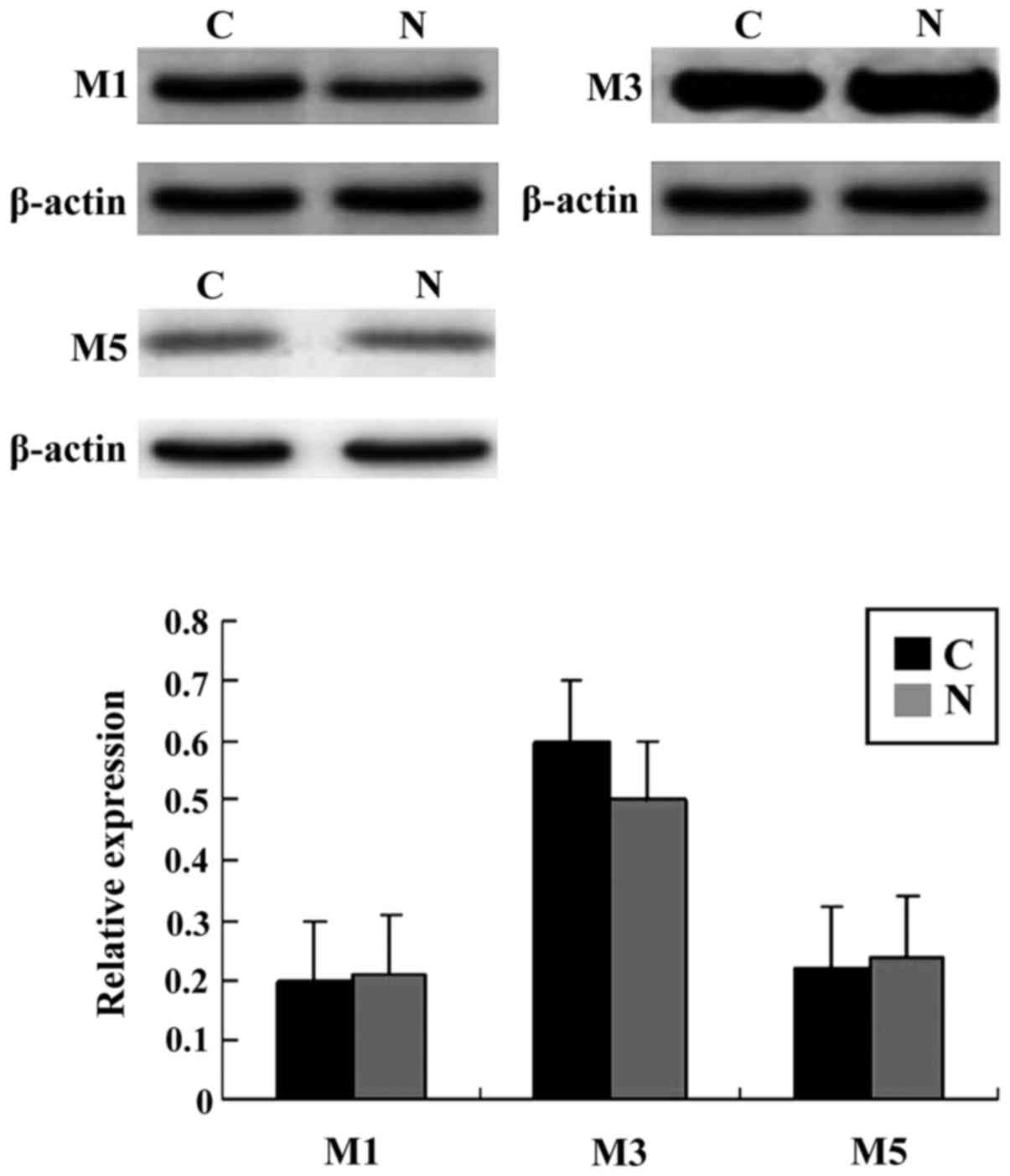Influence of exposure to nicotine during pregnancy on the learning and memory for adult offspring
- Authors:
- Published online on: January 3, 2018 https://doi.org/10.3892/etm.2018.5687
- Pages: 2404-2410
-
Copyright: © Ma et al. This is an open access article distributed under the terms of Creative Commons Attribution License.
Abstract
Introduction
During the full-term pregnancy of humans, the embryonic phase is a very important and indispensable critical period. The environment of the maternal body during pregnancy is of great significance to the growth of fetus and its organs as well as for the physical condition of the future infant (1). The well-known concept of ‘imprinting’ means that if the environment of the maternal body in embryonic phase is poor, such as exposure to toxic chemical substances and malnutrition, then babies suffer through changes of physical condition at the post-partum stage or even when they grow into adults. Serious conditions mean that they have poorer capability to bear certain diseases compared to the common people (2). Among the smoking population of the whole world, the Chinese smoking population accounts for a large proportion, up to 33.3% based on current data. Thus, the passive smoking population is too large to imagine. On the other hand, in recent years, the female smoking population in China has gradually been rising (3). The data fully demonstrate that in China, which covers a large smoking population, females are suffering from damage of nicotine to different degrees, especially females that are preparing for pregnancy or pregnant females, who deserve much more attention in this respect (4). Nicotine, also called nicotinamide or alkaloid, is an important ingredient from all of the tobacco species, mainly extracted from the Solanaceae plants. Regardless of whether active smokers or passive smokers, persond will take in certain nicotine through the nasal or oral mucosa, and then nicotine will be absorbed through the mucosa in different positions and further absorbed by the brain cell tissue via blood-brain barrier (BBB) after circulation (5). When the nicotine arrives at central tissue cells, the body will be in a relatively exciting status. The long-term use of nicotine can cause dependency to a certain degree, and more seriously, it may lead to addiction, also called the the ‘rewarding effect’ (6). All ways of learning and memory for higher animals are produced in the central nervous system, which indicates indirectly that nicotine has a different impact on different aspects of learning and memory (7). Various opinions can be summarized according to the literature that relates to direct influence of nicotine on the learning and memory of mice. Some scholars believe that if mice were given a small dose of nicotine in a short time before training in the water maze, the time that mice took to arrive at the terminal was longer than that of the mice in the control group, which were given regular drug-free water, and this indicates that nicotine has a certain interference effect on the learning and memory of mice (8).
Every individual has to develop both the learning and memory functions. In all brain functions, learning and memory are two inseparable parts. Thus, when an individual adapts to an external environment, the process of receiving external information to improve itself is called learning, and memorization is the process of extracting and saving some learned content in the brain tissue (9). NMDAR is an important receptor component of glutamic acid, which is the significant excitatory amino acid (EAA) of the central nervous system. In all brain tissue cells, the hippocampus is distributed with the highest NMDAR, and is the widest distribution area (10). NMDAR is an important neurotransmitter for promoting the learning and memory of bodies, and is involved in the whole process of learning and memory. Based on the newest research, NMDAR has seven or greater than seven subunits. Acetylcholine receptors are divided into muscarinic receptors and nicotine receptors. The former is also subdivided into the M1-M5 subtype, with different subtypes playing different roles in the learning and memory process. The nicotine receptor is also subdivided into α and β subunits. In all nicotine receptors, the α7 subunit is most closely correlated with the learning and memory process of bodies, and nicotine mainly influences central neurological functions, which mediates bodies, through nicotine receptors (11).
The early Morris water maze experiment analyzes the learning and memory capabilities of animals. In the external environment with water, the survivability of rodent animals are greatly reduced. In the experiment, the Morris water maze set up a platform that was beneficial to the escape of animals. Since rodents are afraid of water, they collect the space clues that seek all available places to escape all external environment with water (12). Therefore, this experiment is able to investigate the influence of nicotine on the learning and memorization capabilities of the adult offspring by the water maze method.
Materials and methods
Experiment materials and grouping
Clean adult C57 mice were selected as the subjects of this experiment. Male mice that weighed between 20–30 g, and female between 25–30 g. All mice were obtained by the Jinan Peng Yue Experimental Animal Breeding Cο., Ltd. (Jinan, China). All female and male mice were grouped with a proportion of 1:1. The morning of next day when the sperm was found on the vaginal smear it was taken as the first day of pregnancy (GD1).
Thirty pregnant mice were selected and randomly divided into either the control group (CON) or the nicotine group (NIC), with 15 mice in each group. Only the pregnant mice in the control group were given drug-free water, while the pregnant mice in the nicotine group were given drinking water with a concentration of 60 µg/ml nicotine. The mice in the NIC group were not given nicotine until the 21st day of the birth of filial mice (PD21). In the NIC group nicotine exposure was stopped and mice were allowed to drink drug-free water, while the CON group was always given free water. The filial mice were selected on PD50 in order to conduct related experiments. The study was approved by the Ethics Committee of the First People's Hospital of Xuzhou.
Experiment steps and test index of Morris water maze
The processing analysis system of Morris water maze (Beijing Shuolinyuan Science and Technology Co., Ltd., Beijing, China) consists of three parts. Namely, the third quadrant middle platform with a diameter of 6 cm, a round pool with diameter of 100 cm and the monitoring system. The platform was below the water surface by 3 cm, and the temperature in the pool was kept at 25±2°C. Two adult mice were randomly selected from the eight litters of mice in this experiment; the whole experiment was divided into four phases.
Place navigation test
A new entry point was randomly selected on each day of the experiment, and the entry point of each adult mouse was consistent. The time was calculated when each mouse was put into the pool. Two minutes was set as the schedule time, and the mice were required to find a platform within the fixed time. The time of finding the platform in the pool and route map of each adult mouse was recorded. The adult mice were trained 4–5 times each day, with one week as the total training time. The place navigation test was mainly used for testing memory capabilities.
Apace exploration experiment
Six hours after the place navigation test was finished, the platform was removed, and then the adult mice took the middle of the first quadrant edge as an entry point. The percentage of stay duration of each mouse in the third quadrant was within 2 min as well as the total times crossing the earliest platform were calculated. Such process was taken as one test. The constant-bearing navigation and space exploration experiment were applied for testing the reference memory of adult mice. These tests can indirectly demonstrate the damage of exposure to nicotine during pregnancy on the reference memory of filial mice.
Counterpoint place navigation test and counterpoint space exploration experiment
These two tests were conducted the same way, and were similar to the constant-bearing navigation, that is, the position of platform was changed. On the 10th day of the experiment, the position of platform was adjusted, and set in the diagonal quadrant of platform position in the place navigation test. Each mouse in experiment was trained 5 times each day for 5 continuous days. The counterpoint place navigation test and counterpoint space exploration experiment were mainly used for testing the damage degree of nicotine exposure during pregnancy to the working memory of filial mice.
Testing index
i) The total times of crossing platform. In the space exploration experiment and counterpoint space exploration experiment, the total times of crossing platform of adult mice were calculated; ii) the escape latency time: In the place navigation test and counterpoint place navigation test, the total times that the adult mice in the NIC group took to find platform in the pool was calculated.
Gene detection method
Real-time PCR method was used in this experiment to observe mRNA levels of NR1 and α7nACh in the hippocampus of adult offspring mice. Hippocampus tissue (150 mg) of adult mice in each group was selected, and pulverized. After full ventilation and blending, 150 µl of the chloroform liquid was added. After full blending again, the sample was kept standing at room temperature for 5 min. Then, it was centrifuged at the speed of 3,520 × g for 20 min. The mixed solution was divided into two layers. The clear liquid in the upper layer was absorbed and dried again at room temperature. The RNA enzyme melting was adopted for RNA sediment. After final blending, a real-time PCR method was adopted.
Protein detection method
The western blot analysis was adopted to observe the influence of exposure to nicotine during pregnancy on the protein levels of NR1 and α7nACh in the hippocampus and protein level of muscarinic receptor (M1, M3 and M5 receptors) in hippocampus of adult offspring mice. Ηippocampal tissues (80 g) of adult mice were selected in each experimental group and were made into powder under the liquid nitrogen condition. Then, the moderate cytolysate was added properly. After fully blending and when cells were entirely dissolved, the sample was incubated for 20 min at 0°C, and then centrifuged at a speed of 3,520 × g for 20–30 min. When the liquid was divided into two layers, the supernatant was absorbed for testing at the optical density (OD) value of 600 nm. The colorimetric method was adopted to calculate the concentration of protein, and finally, glue filling, and the sample loading was done. The transfer box was set up strictly based on a certain order. The detection reagent was dried and then the concentration of protein was calculated and analyzed.
1H-MRS detection method test
Before the 1H-MRS detection, all experimental subjects were required to strictly restrain food intake for 10 h. The 1H-MRS instrument and 2.0 MR scanners were imported from Germany. In the process of testing, all experimental subjects were fixed in the prone position with a good external environment. All cross-sectional imaging was scanned with the T1 WI coronal view. All scanning process and results calculation were jointly completed by three imaging physicians.
Statistical analysis
The experimental data of each group were expressed as mean ± SEM. The GraphPad Prism and the SPSS 18.0 statistical software (SPSS Inc., Chicago, IL, USA) were used for statistical analysis. All experiment results were detected using a two-way analysis of variance (ANOVA) class t-test with the average of two samples. P<0.05 was considered to indicate a statistically significant difference.
Results
Comparison of latency time between adult offspring mice in the NIC group and the CON group
The swimming paths of the NIC group and the CON group in experiment process were drawn (Fig. 1). It was obvious that latency time of both groups was reduced along with an increase of exercise times. In the place of the navigation test, the latency time of the NIC group was longer than that of the CON group and the time to reach the plate for the NIC group was also longer than that of the CON group (P<0.05) (Figs. 2 and 3; Table I).
Comparison of spatial probe test and couterpoint spatial probe test between the NIC group and the CON group
After the place navigation test, the plates were withdrawn from the pool. Frequency of passing the plate of mice in the two groups within 2 min were detected. Results indicated that the frequency of passing plate of mice in the NIC group was less than that of the CON group (P<0.05). However, in the spatial probe test, comparison of the frequency of passing plates between the two groups revealed that there were no significant differences (Figs. 4 and 5).
Comparison of levels of mRNA and protein of NR1 between the NIC group and the CON group
The expression levels of mRNA and protein of NR1 in the hippocampus tissues of the NIC group were significantly increased compared to that of the CON group (P<0.05). Differences were statistically significant (Figs. 6 and 7).
Comparison of levels of mRNA and protein of α7nACh between the NIC and the CON groups
The comparison of the expression levels of mRNA of α7nACh in the hippocampus tissues of the adult offspring mice between the NIC group and the CON group revealed no significant changes (P>0.05) while the expression levels of protein was significantly reduced than the CON group (P<0.05). Differences were statistically significant (Figs. 8 and 9).
Comparison of the expression level of protein of muscarinic receptor between the NIC group and the CON group
Comparison of the expression levels of protein of M1, M3, M5 in hippocampus tissues of adult offspring mice between the NIC group and the CON group revealed no significant changes (P>0.05). Differences were of no statistical significance (Fig. 10).
Comparison of hippocampus metabolites between the NIC group and the CON group
Metabolites such as NAA and Cho in the hippocampus tissues of adult offspring mice were detected using 1H-MRS. Comparison of the metabolites between the NIC group and the CON group revealed that the NAA/Cr and Cho/Cr values of the NIC group were higher than those of the control group. However, the NAA/(Cho+Cr) value of the NIC group were lower than those of the control group (P<0.05). Differences were not statistically significant (Table II).
Discussion
Nicotine, via blood circulation in the body, finally arrives at the central nervous system through the BBB. In the central nervous system, nicotine is mostly combined with nicotinamide cholinergic receptor, which is a relatively special ion channel receptor, mainly controlled by a ligand (13). The nACHRs have many subunits, with each subunit playing a different role. Moreover, each subunit has different compatibility with nicotine. Related research has found that in all subunits, α4β2 has the strongest compatibility with the nicotine in the central nervous system. Receptors are mainly distributed in the hippocampus. The combination of receptors of various subunits of nicotine will promote the synthesis and release of multiple neurotrans-mitters, e.g., glutamic acid. The whole process of learning and memory is mediated this way (14). Indirect effects of nicotine to subjects during pregnancy, types of administration, intramuscular injection, intravenous injection and direct drinking, may produce different results. Drugs were administered by direct drinking in this experiment, which, to some degree, can reduce the stimulus of intravenous injections to mice during pregnancy and lactation after pregnancy in many aspects (15). Each pregnant mouse drinks ~60 µg/ml nicotine each day, which means that each pregnant mouse takes in 0.40 mg nicotine each day. Such dose will not cause a toxic reaction and death of pregnant and offspring mice. As related to human beings, this dosage refers to adults weighing 60–65 kg that smoke 15–20 cigarettes each day. Therefore, the intake of nicotine adopted in this experiment is feasible and comparable to practice.
The muscarinic receptor plays an important role in the pathophysiology of human beings (16). It is widely distributed in the various glands of the human body, such as the cardiac and smooth muscle. In the process of nerve conduction, muscarinic receptors may promote system activation and may inhibit the conduction of nerve excitation (17). In addition, it can mediate and adjust the highest learning and memory functions of bodies (18). The muscarinic receptor can be divided into many subtypes, including M1-M5, and each subtype playing a different role in the process of learning and memory of bodies. According to the distribution of muscarinic receptors in the hippocampus of mice, the M1, M3 and M5 receptors have the widest distribution, while the distribution of M2 and M4 is relatively sparse. It can be seen that receptors of M1, M3 and M5 do not cause damage in the process of nicotine damaging subjects during pregnancy, however, much more effective evidence is necessary for verification (18). In addition, in the influencing process of nicotine on mice during pregnancy, the NMDA receptor also plays an important role. It mainly maintains the function of nerve conduction. The NMDA can both promote learning and memory and resist weakening of learning and memory (19). When plenty of calcium ions flow internally, the intracellular mitochondria are damaged, and the death rate of cells is increased, thus the learning and memory is restrained. This experiment has indicated that the expression of NR1 at the mRNA and protein levels can reduce the learning and memory capability of adult mice (20). The most frequently-used method to detect the related products of body brain tissue is 1H-MRS, the results of which are tested and verified based on the principle that different products have different crests. The most typical marker of the neuron is NAA. In addition, the level of NAA in the body can reflect the activity of nerve cells. Cho is mainly involved in the synthesis of cell membrane and mainly reflects the change of amount of nerve cells. This experiment demonstrated that the nicotine damage to pregnant mice can cause a reduction of NAA and Cho levels in the mouse body. 1H-MRS is of great significant in detecting the change of metabolites in the brain, especially in the hippocampus and can provide strong evidence and support for promoting the influence of nicotine on the learning and memory of offspring mice. The influence of intake of nicotine during pregnancy on offspring, whether for body or learning and memory, is great and non-reversible. Considerable experimental data indicate that the intake of nicotine during pregnancy will seriously influence the formation and further development of the offspring's brain tissue. Therefore, reducing the intake of nicotine during pregnancy, by active or passive smoking, should be an issue that deserves much more attention from the whole society.
Acknowledgements
The present study was funded by the Open Project of Jiangsu Provincial Key Laboratory of Anesthesiology (project no. kjs1506).
References
|
Sepehri G, Parsania S, Hajzadeh MA, Haghpanah T, Sheibani V, Divsalar K, Shekarforoush S and Afarinesh MR: The effects of co-administration of opium and morphine with nicotine during pregnancy on spatial learning and memory of adult male offspring rats. Iran J Basic Med Sci. 17:694–701. 2014.PubMed/NCBI | |
|
Gold AB, Keller AB and Perry DC: Prenatal exposure of rats to nicotine causes persistent alterations of nicotinic cholinergic receptors. Brain Res. 1250:88–100. 2009. View Article : Google Scholar : PubMed/NCBI | |
|
Kirch DG, Gerhardt GA, Shelton RC, Freedman R and Wyatt RJ: Effect of chronic nicotine administration on monoamine and monoamine metabolite concentrations in rat brain. Clin Neuropharmacol. 10:376–383. 1987. View Article : Google Scholar : PubMed/NCBI | |
|
Lee EH: Effects of nicotine on exploratory behavior in rats: Correlation with regional brain monoamine levels. Behav Brain Res. 17:59–66. 1985. View Article : Google Scholar : PubMed/NCBI | |
|
Shearman E, Fallon S, Sershen H and Lajtha A: Nicotine-induced monoamine neurotransmitter changes in the brain of young rats. Brain Res Bull. 76:626–639. 2008. View Article : Google Scholar : PubMed/NCBI | |
|
Grandjean P and Landrigan PJ: Neurobehavioural effects of developmental toxicity. Lancet Neurol. 13:330–338. 2014. View Article : Google Scholar : PubMed/NCBI | |
|
Oberg M, Jaakkola MS, Woodward A, Peruga A and Prüss-Ustün A: Worldwide burden of disease from exposure to second-hand smoke: A retrospective analysis of data from 192 countries. Lancet. 377:139–146. 2011. View Article : Google Scholar : PubMed/NCBI | |
|
Wadi MA and Al-Sharbatti SS: Relationship between birth weight and domestic maternal passive smoking exposure. East Mediterr Health J. 17:290–296. 2011.PubMed/NCBI | |
|
Polańska K, Hanke W, Sobala W and Ligocka D: Exposure to environmental tobacco smoke and psychomotor development of children. Med Pr. 60:15–20. 2009.(In Polish). PubMed/NCBI | |
|
Hernández-Martínez C, Arija Val V, Escribano Subías J and Canals Sans J: A longitudinal study on the effects of maternal smoking and secondhand smoke exposure during pregnancy on neonatal neurobehavior. Early Hum Dev. 88:403–408. 2012. View Article : Google Scholar : PubMed/NCBI | |
|
Li J, Bo L, Zhang P, Gao Q, Li L, Tang J, Wu C, Li D, Xiao J, Chen J, et al: Exposure to nicotine during pregnancy and altered learning and memory in the rat offspring. Nicotine Tob Res. 17:661–666. 2015. View Article : Google Scholar : PubMed/NCBI | |
|
Rogers JM: Tobacco and pregnancy. Reprod Toxicol. 28:152–160. 2009. View Article : Google Scholar : PubMed/NCBI | |
|
Talarowska M, Gałecki P, Maes M, Orzechowska A, Chamielec M, Bartosz G and Kowalczyk E: Nitric oxide plasma concentration associated with cognitive impairment in patients with recurrent depressive disorder. Neurosci Lett. 510:127–131. 2012. View Article : Google Scholar : PubMed/NCBI | |
|
Yang J, Jiang LN, Yuan ZL, Zheng YF, Wang L, Ji M, Shen ZQ, Wang XW, Ma Q, Xi ZG, et al: Impacts of passive smoking on learning and memory ability of mouse offsprings and intervention by antioxidants. Biomed Environ Sci. 21:144–149. 2008. View Article : Google Scholar : PubMed/NCBI | |
|
Thompson DK, Omizzolo C, Adamson C, Lee KJ, Stargatt R, Egan GF, Doyle LW, Inder TE and Anderson PJ: Longitudinal growth and morphology of the hippocampus through childhood: Impact of prematurity and implications for memory and learning. Hum Brain Mapp. 35:4129–4139. 2014. View Article : Google Scholar : PubMed/NCBI | |
|
Aycicek A, Varma M, Ahmet K, Abdurrahim K and Erel O: Maternal active or passive smoking causes oxidative stress in placental tissue. Eur J Pediatr. 170:645–651. 2011. View Article : Google Scholar : PubMed/NCBI | |
|
Phesse TJ, Myant KB, Cole AM, Ridgway RA, Pearson H, Muncan V, van den Brink GR, Vousden KH, Sears R, Vassilev LT, et al: Endogenous c-Myc is essential for p53-induced apoptosis in response to DNA damage in vivo. Cell Death Differ. 21:956–966. 2014. View Article : Google Scholar : PubMed/NCBI | |
|
Jedrychowski W, Perera FP, Jankowski J, Mrozek-Budzyn D, Mroz E, Flak E, Edwards S, Skarupa A and Lisowska-Miszczyk I: Very low prenatal exposure to lead and mental development of children in infancy and early childhood: Krakow prospective cohort study. Neuroepidemiology. 32:270–278. 2009. View Article : Google Scholar : PubMed/NCBI | |
|
Mukhopadhyay P, Horn KH, Greene RM and Michele Pisano M: Prenatal exposure to environmental tobacco smoke alters gene expression in the developing murine hippocampus. Reprod Toxicol. 29:164–175. 2010. View Article : Google Scholar : PubMed/NCBI | |
|
Hoyert DL, Arias E, Smith BL, Murphy SL and Kochanek KD: Deaths: Final data for 1999. Natl Vital Stat Rep. 49:1–113. 2001. |



